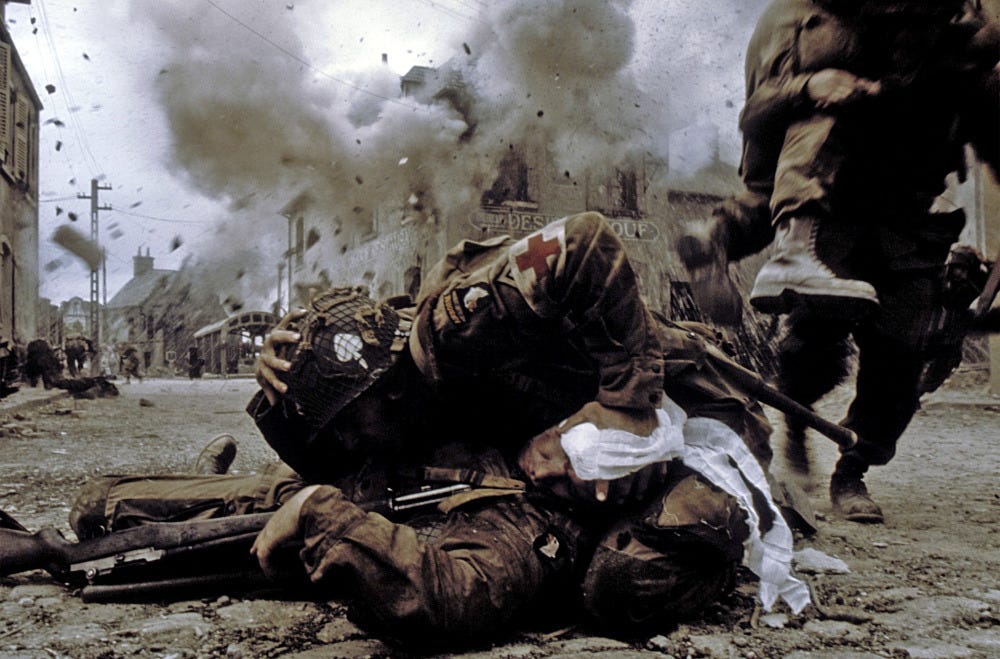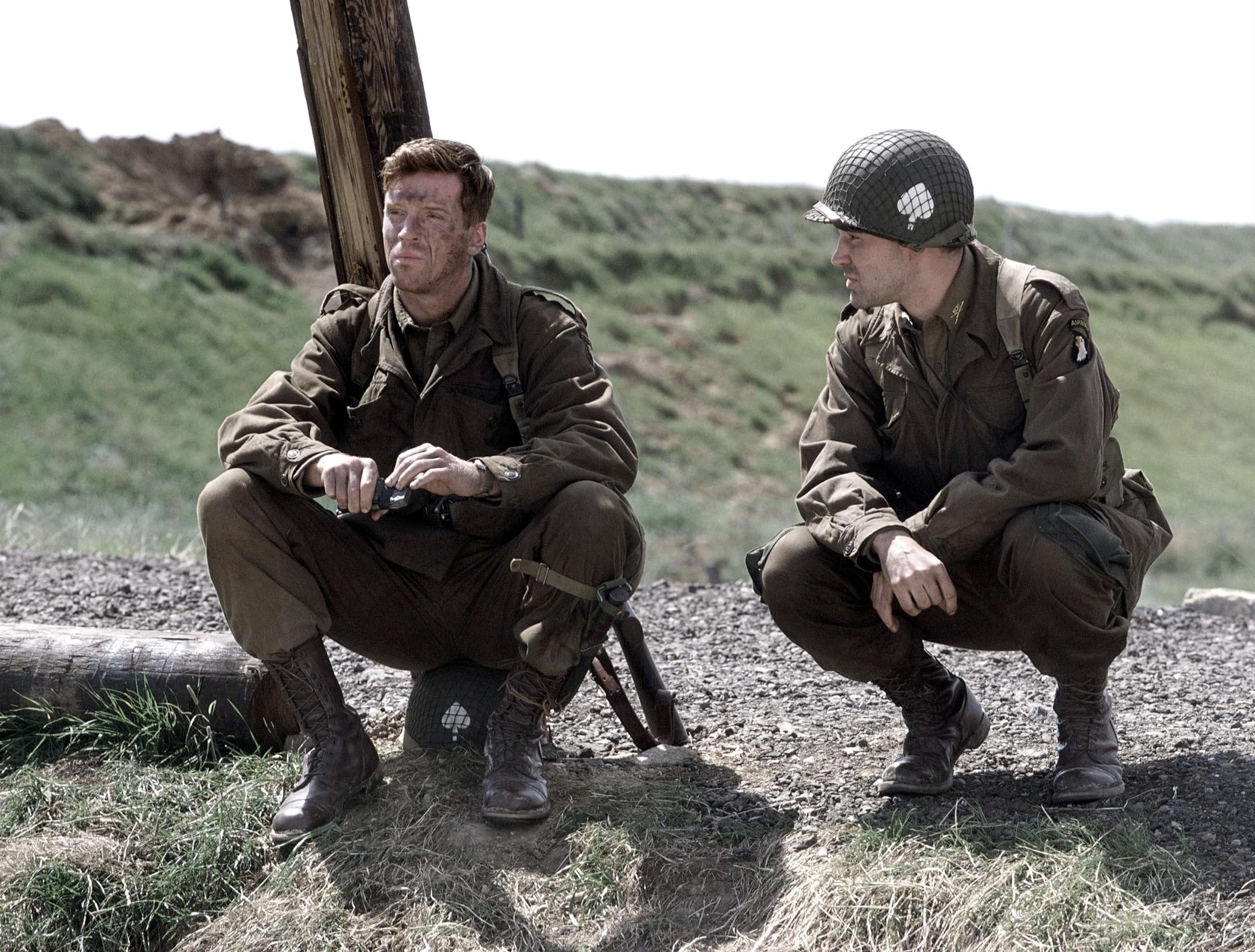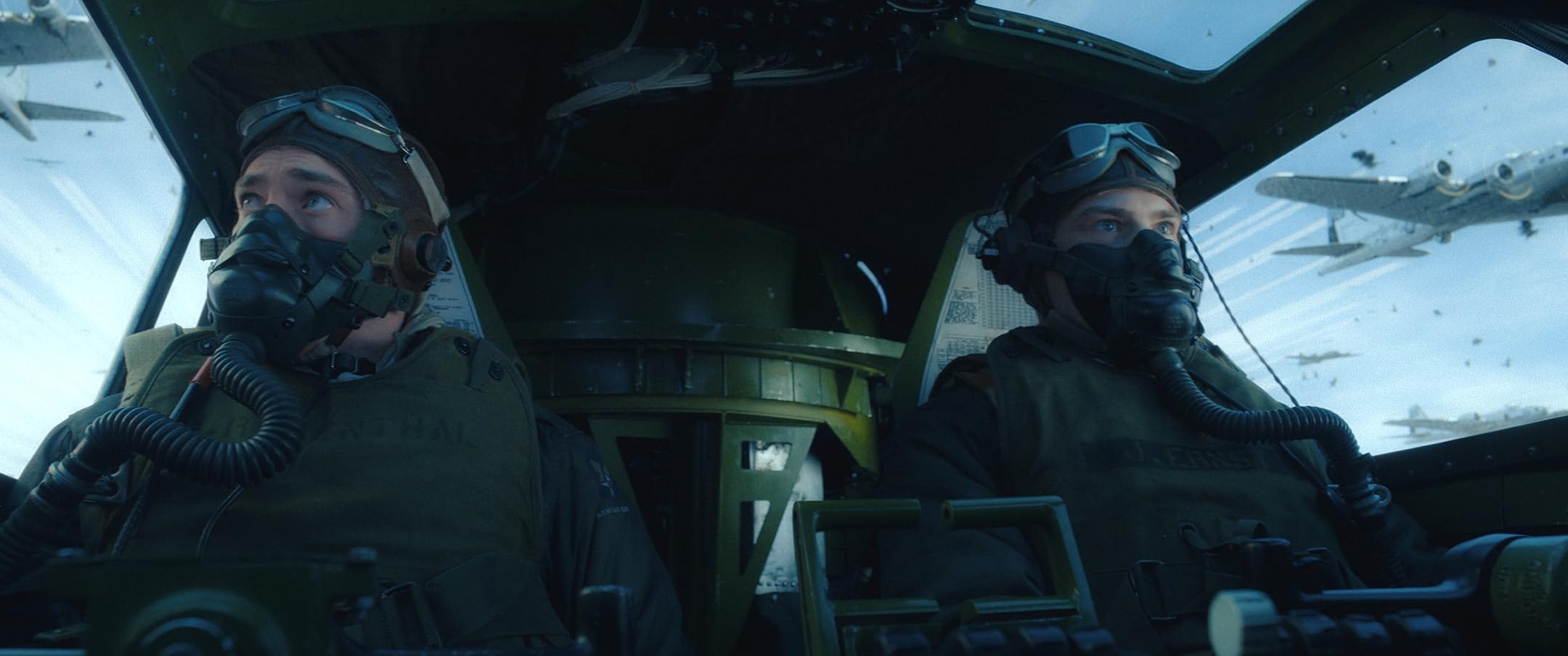The Biggest War on the Small Screen
On this eightieth anniversary of D-Day, here’s why ‘Band of Brothers’ works so well, ‘The Pacific’ less so, and ‘Masters of the Air’ just doesn’t.
AFTER A STINT IN THE MARINE CORPS during which he won a Purple Heart in Vietnam, the father of a friend of mine developed a new hobby as an amateur film critic. His niche was war movies, and his unique angle was to offer exacting critiques of their historical and military accuracy. He cared that each soldier’s (or, he would be quick to add, Marine’s) story was told right, without anachronism or needlessly unrealistic portrayals of military life and combat.
There was only one depiction of war that ever fully satisfied his discerning eye: Band of Brothers, the 2001 HBO miniseries developed by Steven Spielberg and Tom Hanks based on the book of the same name by Stephen Ambrose. It was, my friend’s dad declared, the most realistic depiction of combat he’d ever seen.
Band of Brothers was a critical success—it won seven Emmys, including Outstanding Miniseries, and was nominated for thirteen more. Perhaps no encapsulation of the show’s artistic and historical accomplishment is better than its citation for a Peabody Award:
Band of Brothers recounts the full sweep of the war in the European Theatre, from training camps to D-Day, through the liberation of concentration camps and on to the capture of Hitler’s Eagle’s Nest. But the production never fails to bring historic events and mighty decisions down to the level of single actions, to the loyalties that bind soldier to soldier. In so doing it reminds us of the deeper personal costs of war and of the significance of individual choices made in terrible circumstances. . . . These actors portrayed the lives of real men, many of whom appeared throughout the series in deeply moving interview segments.
The commitment to historical detail is absolute. Many of the details, like the special armbands the paratroopers wore to detect chemical weapons, go unremarked upon within the show. They cost extra money for the production, but they never entered into the plot. They were there just because it was important to tell the story with as much authenticity as possible.
There’s no mythmaking here: Episode by episode, the characters commit acts of iron courage along with rank cowardice; tender mercy—as when Pvt. Donald Malarkey (Scott Grimes) of Astoria, Oregon stops to reminisce with a German prisoner of war who grew up in Eugene—and war crimes, as when, moments later, Lt. Ronald Speirs (Matthew Settle) is depicted machine-gunning that American-born POW along with a group of others. (Faithful to the historical evidence, the series leaves some ambiguity as to whether Speirs actually killed the POWs; there were rumors that he had ordered their execution, and the real-life Maj. Richard Winters [played in the series by Damian Lewis] later noted that Speirs “worked hard to earn a reputation as a killer and often killed for shock value.”)
What makes Band of Brothers particularly effective, though, is that it marries fastidious historical reenactment to video interviews with the men it depicts. Winters is the primary protagonist of the series, and he and a host of others describe their experiences in their own words at the beginning of each episode. The series takes on a documentary aspect. It would be disrespectful to mar the stories of these veterans—and those who didn’t survive to be interviewed—with petty historical errors. The overriding theme of Band of Brothers is: Look at what these men achieved.
Band of Brothers wasn’t just about a moment in history; it was part of a moment in history. It premiered 56 years and one week after the end of World War II (and just a couple of days before 9/11). The soldiers who were in their late teens or early twenties as they fought their way through Europe were in their seventies and eighties during the show’s run. Today, a private who was just 18 at the very end of the war would be 97 years old. There just aren’t that many of them left.
Put it another way: We are now as far away from John McCain’s capture in North Vietnam as the premiere of Band of Brothers was from D-Day. And we are as far from D-Day as it was from Sherman’s march to the sea.
THERE WAS, OF COURSE, ANOTHER SIDE OF THE WAR on the other side of the world. If you had told someone in the weeks after Pearl Harbor that Americans’ strongest memories of World War II would be set predominantly in Europe and not the Pacific, they probably would have been shocked and confused, yet the eightieth anniversary of D-Day is a much larger cultural event than the eightieth anniversary of the Battle of Midway was two years ago. Maybe the anniversary of the Battle of Iwo Jima in January will garner larger acts of commemoration.
Nine years after Band of Brothers premiered, Spielberg and Hanks, plus producer Gary Goetzman, began making The Pacific. Instead of taking a linear history of one unit as their source material, as they had for Band of Brothers, they combined two memoirs by Marines who had served in the war against Japan—With the Old Breed: At Peleliu and Okinawa by Eugene Sledge (played in the series by Joseph Mazzello) and Helmet for My Pillow: From Parris Island to the Pacific by Robert Leckie (played by James Badge Dale)—with the story of Sgt. John Basilone, a Medal of Honor recipient and one of the most famous Marines in history.
The direct-to-camera interviews that deepened the gravitas of Band of Brothers were impossible to recreate for The Pacific. Eugene Sledge and Robert Leckie had both died in 2001, the year Band of Brothers premiered, at ages 77 and 81 respectively. (Basilone gave his life on Iwo Jima in 1945 at age 28.) In 2001, there were more than 5 million World War II veterans still alive in the United States. By 2007, that number had declined to about 2.5 million, and they were dying at the rate of “one thousand a day,” reported Ken Burns in his documentary of that year, The War. It would have been much harder—perhaps impossible—for Spielberg, Hanks, and Goetzman to have found enough veterans of the battles they depicted willing to do interviews during the later show’s production. That generation was passing away, and with them, their memories were disappearing.
The memory evoked by The Pacific is tonally and morally different from that preserved by Band of Brothers. Some of this difference can be attributed to the source material. According to his widow, Leckie wrote Helmet for My Pillow after walking out midway through a performance of South Pacific on Broadway. He worried that people would think “Bali Ha’i” was what the war was like.
If anyone had that illusion, The Pacific would dispel it. The scene in which Sledge falls down a slope into a soaking, partially decayed corpse crawling with maggots is enough to inspire insectophobia. In another scene, during a bit of downtime, Cpl. Merriell “SNAFU” Shelton (Rami Malek) casually tosses pebbles into the bottom half of what was once a Japanese soldier’s cranium. The top half of the man’s head is missing, but the face is still visible, and each stone lands in the liquefied remains of his brain with a round, resonant plunk.
There’s more like that. The Marines have a habit of using their Ka-Bar knives to pry out the gold fillings from the teeth of dead—or merely wounded—Japanese soldiers. The Japanese have a penchant for torturing American POWs to death and leaving their corpses—with hands, feet, faces, and crotches reduced to bloody pulp—for the Americans to find. These depictions are fitting representations of the barbarity of the Pacific War, which was suffused with racial animus on both sides that went far beyond what most (but not all) combatants in Western Europe experienced.
But it’s hard not to notice that America wasn’t in a mood for the majesty of righteous military triumph when The Pacific was being made in 2010. Band of Brothers premiered during the post-Gulf War/Bosnia/Kosovo feeling of technological and moral superiority and continued its first airing during the surge of patriotism after 9/11. Those feelings waned as the wars in Afghanistan and Iraq dragged on without satisfactory conclusions—there were no parades up Broadway to celebrate Victory in Afghanistan Day or Victory in Iraq Day. The Pacific’s depiction of America’s fighting men less as victors than as victims of a larger system of violence fit a moment in which people were starting to assume that most veterans had PTSD and came home from war broken wrecks.
The theme of The Pacific is not Look at what these men achieved but Look at what these men endured. It has little of the nobility of Band of Brothers—just misery.
THERE’S ALWAYS MORE OF THE WAR TO TELL. Hanks and Spielberg teamed up again to tell the story of the Eighth Air Force, which led the strategic bombing of Germany and occupied Europe from bases in England. This one unit of the Army Air Force suffered more casualties than the entire Marine Corps, yet its story is often overlooked. Images, to say nothing of videos, of World War II–era aerial combat are relatively rare, and from afar, lumbering bombers can even seem majestic and peaceful—especially compared to their targets on the ground.
Masters of the Air, which Hanks and Spielberg began developing with HBO in 2012 but which was ultimately developed and released by Apple TV+ earlier this year, partially fills the gap in our national memory. Based primarily on Donald L. Miller’s Masters of the Air: America’s Bomber Boys Who Fought the Air War Against Nazi Germany, the series follows the men of the 100th Bomb Group, part of the Eighth Air Force, known as the “Bloody Hundredth” because of their astronomical casualty rate.
The main contribution of Masters of the Air to our public understanding of the war is in its depiction of aerial combat. It isn’t romantic or chivalrous. It isn’t graceful. It isn’t easy. It’s gory and terrifying. Each B-17 bomber had a crew of ten men, most of whom were exposed at a series of machine-gun posts around the fuselage to shoot at enemy fighter planes. In the third episode, Sgt. William Quinn (Kai Alexander) tries to rescue Sgt. William “Babyface” Hinton (Oaklee Pendergast), who’s trapped inside his ball turret on the belly of their plane, which is disintegrating as it plummets to the earth. The rest of the crew has already bailed out with their parachutes, and as they lose altitude, Quinn has to decide whether to keep trying to save his friend at the risk of both their lives. It’s a torturous moment that encapsulates the unique horrors of combat thousands of feet above the earth.
But that’s just about the only contribution Masters of the Air makes. While Miller’s Masters of the Air was the primary source for the series, the actors, writers, and directors also relied on memoirs like Harry Crosby’s A Wing and a Prayer.1 Yet the intimacy and immediacy of the text doesn’t translate to the screen as it did in The Pacific; its characters lack nuance and depth. Too often they’re mirrors rather than canvases, reflecting the stresses of combat but depicting precious little individuality. The most obvious example is the friendship between Maj. Gale “Buck” Cleven (Austin Butler) and Maj. John “Bucky” Egan (Callum Turner)—yes, the main characters are called Buck and Bucky—which is too often explained rather than embodied.
Of course, because development started initially in 2012 and the show didn’t premiere until this year, there was no way to recreate the immediate connection to the events of the show that gave Band of Brothers, with its veteran interviews, its unique power. But it also fails to convey the emotional effect of the memoirs that informed it as well as The Pacific did. As a result, Masters of the Air feels less real than its predecessors.
And the disregard for historical accuracy doesn’t help.
In the fourth episode, Egan takes a leave in London, which is portrayed as being under aerial bombardment. This makes no sense: The episode takes place in the fall of 1943 and its main set piece is the October 8 bombing run over Bremen—one of many such missions the Bloody Hundredth and other elements of the RAF and Eighth Air Force conducted throughout the war. The Blitz had ended more than two years before, so London was no longer under attack by German bombers, and the first V-1 flying bombs weren’t launched until mid-1944. The only apparent reason for depicting London burning in the fall of 1943 was to provide a more scenic backdrop to Egan’s tryst with a Polish widow.
What’s the point of telling the stories of Egan, Clevan, and the other men of the Bloody Hundredth if the story of the war they fought gets mangled along the way?
It gets worse. One pilot, Maj. Robert “Rosie” Rosenthal (Nate Mann), is shot down over the Eastern Front and ends up wandering into a prison camp at Żabikowo, Poland, where he has a clumsy encounter with a Yiddish-speaking man and places his hands on a Star of David inscribed on the wall of a gas chamber. The series leans just enough into the Holocaust to steal some gravity and seriousness for itself, but not enough to say anything interesting or insightful—and it simply does not grapple with the real interactions between the Eighth Air Force and the ongoing genocide, such as the Army’s decision to exclude death camps from its target lists.
The Tuskegee Airmen are shoehorned in at the very end of the series. Masters of the Air finds a sour spot in telling their stories. The series clearly doesn’t want them to become afterthoughts, but the men also don’t get the time or attention befitting an adequate historical treatment. Their story lands somewhere in the middle. What they deserve is their own series—and hopefully a better, more accurate one.
In the way that Band of Brothers is almost a documentary, Masters of the Air is almost a video game. The theme of the latter isn’t achievement or endurance; it’s Big loud plane go boom.
My friend’s dad is no longer with us. He now lies beneath one of those thousands and thousands of neat, white headstones in long rows in American military cemeteries around the world. So he never saw Masters of the Air. But I have a pretty good idea what he would have thought of it.
AT THE NEXT ROUND-NUMBER ANNIVERSARY of D-Day, there will be none left who remembers it. But that doesn’t mean we can’t preserve the memory of those who did great and terrible things in the war. World War I was more than a century ago, yet our cinematic remembrances of it aren’t limited to Wonder Woman, which is no less cartoonish and silly than any other Marvel movie. We also have, from just the last few years, Sam Mendes’s 1917, Peter Jackson’s They Shall Not Grow Old, and Edward Berger’s All Quiet on the Western Front.
The attention we are paying to the anniversary of D-Day indicates just how much our collective memory of World War II still matters to us. Just because we’re losing the last members of the generation that won the war doesn’t mean we have to lose the memory, let alone lose ourselves to the trivialities of cheap myths gussied up with CGI explosions. There’s a place for video games, sure—but there’s also a place for the authenticity, not to mention verisimilitude, that comes from fidelity to the details of history. It not only honors those who gave the last, full measure of devotion. It also enlightens us.
Correction, June 7, 2024, 10:51 a.m.: An earlier version of this article omitted that the writers and actors of Masters of the Air consulted memoirs, including Crosby’s.






